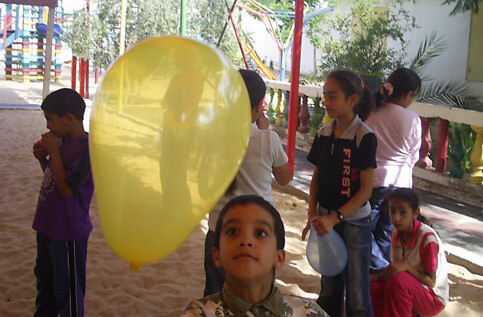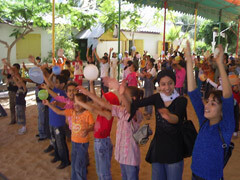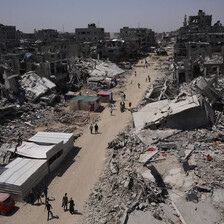Gaza Strip 13 June 2008

A child plays with a balloon during one of the training sessions.
Tuesday morning at 9:00am, 220 Palestinian children gathered at al-Sherouq and al-Amal children’s club in southern Gaza’s Khan Younis refugee camp. Dressed in colorful clothes accompanied by cheerful smiles, the children lined up in rows to listen to their trainer. The children were attending their first day of a three-week-long program of training and activities at the club. “The circumstances around Palestinian society, particularly, the growing violence at many levels, have prompted us to hold this program to train children how to have less violent trends,” explained Najwa al-Farra, chairwoman of the club.
Funded by the Culture and Free Thought Society in Khan Younis, the program “attempts to decrease a great deal of the tension that many of our Palestinian children experience, especially because of sporadic Israeli gunfire and domestic violence,” al-Farra added. She said that over the past year Palestinian society has seen increasing social and economic problems due to the Israeli blockade and repeated Israeli army invasions, which have had a negative impact on the children’s way of life and behavior. The Khan Younis area borders Israel, and has been the site of several invasions by the Israeli army over the past year. During this period, a number of young girls from Khan Younis were killed by Israeli army artillery fire. The latest casualty was nine-year-old Hadeel al-Semairy, who was hit by Israeli tank fire in front of her home on 5 June.
Al-Farra explained that because of the year-long Israeli siege tens of thousands of households are now entirely dependent on food aid, “leading some children to work in order to help support their families.” She added that even those families which don’t require aid have seen their standard of living decline dramatically, with “many heads of families now unable to ensure a good living for their children, such as taking them for beach trips or amusement parks. Therefore, we are trying to compensate for these losses as best as we can”.

Children taking part in the activities.
Pointing to a drawing of a seven-car train on the nearby wall, Abu Jam’a explains “As the train’s arrival is announced, the announcer also tells the children what the new activity will be. We hope this will motivate the children to be much more engaged.”
Rowand al-Saqqa, a 12-year-old girl and activity participant, said that she is benefiting from the activities at the club. She has learned dabke, a traditional Palestinian dance, and spends some time hanging out with new friends. Similarly, Reem al-Farra, an 11-year-old girl, expressed her joy at participating in the program, and explained that she is learning many useful things including awareness of Palestinian folklore, dabke, and basic computer training.
Outside the club, the Israeli siege of Gaza and its devastating impact on Palestinian society continues. The closure, which Israel claims is intended to end rocket fire from Gaza at nearby towns, has created unprecedented poverty and unemployment levels throughout the coastal strip, as well as a shortages of essential food items and commodities. However, inside Gaza, the children have a brief reprieve from the siege, and they prepare for another activity. “Now we arrived at the drawing station, let’s draw, sweethearts!” the train station’s announcer announced.
All images by Rami Almeghari
Rami Almeghari is contributor to The Electronic Intifada, IMEMC.org and Free Speech Radio News. Rami is also a former senior English translator at and editor-in-chief of the international press center of the Gaza-based Palestinian Information Service. He can be contacted at rami_almeghari A T hotmail D O T com.
Related Links





